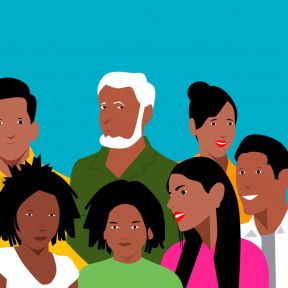
Polyamory
Many people believe that every person should seek a single soulmate, apart from whom they should need no one else. Many others believe that each person should have only one romantic partner, at least at one time. But others don’t think that a single individual can fulfill all of their relationship needs, and therefore they prefer having many partners.
Polyamory, or consensual nonmonogamy, is the practice of having multiple intimate relationships, whether sexual or just romantic, with the full knowledge and consent of all parties involved. Polyamory is generally not gender-specific; anyone can have multiple partners of any gender.
At least one in five Americans has had a consensually nonmonogamous relationship at some point in their lives, and about one in 20 is in one right now. A growing body of research shows that partners in such relationships find their bonds to be just as satisfying and fulfilling as those of married people, and derive just as much happiness from them. But there are serious challenges as well: Polyamorous relationships demand openness, consent, trust, communication skills, clear boundaries, and mutual respect. Feelings of jealousy may arise, especially when a new partner joins the relationship, and debates over how to raise children can also disrupt connections.

Polyamory is distinct from other forms of open relationships, such as swinging—which involves couples having casual sex outside of the relationship, without any emotional attachment. It is often confused with polygamy, or being married to more than one person at the same time, but they are very different. Polygamy specifically involves marriage to multiple people of the opposite gender — most frequently, a man having multiple wives — while polyamory, although it often involves married partners, describes a wider range of relationships, both heterosexual and LBGT.
Due to the stigma that it often attracts, polyamory is often practiced privately and may be kept secret even from close friends and family. At least one in four polyamorous individuals have experienced discrimination, according to the non-profit organization Loving More.
People may take part in many different kinds of nonmonogamy. These extra-dyadic sexual relationships range from polyamory to polygamy to swinging to open relationships — which generally involve committed partners who, either individually or jointly, engage in sexual activity with secondary partners. Other arrangements may include polyfidelity, a closed relationship involving sexual and emotional fidelity to a group larger than two, and relationship anarchy, which rejects conventional cultural standards for relationships.
Legally, polyamory is not recognized as an orientation. But the question of whether it should be is a subject of much debate, even among practicing polyamorists. For sure, many people in consensually nonmonogamous relationships believe it is their orientation, and core to who they are — such individuals often report struggling to find satisfaction in monogamous relationships before “coming out” as poly — but other partners, even those in long-term polyamorous relationships, still see it as a personal choice or lifestyle.
An estimated 21 percent of people in the U.S. have engaged in consensual nonmonogamy at some point, a number that researchers say holds steady across categories of age, race, socioeconomic group, educational level, and political affiliation. At any given time, it is estimated that about 4 or 5 percent of the population is actively involved in such a relationship, but experts believe that number is growing. Men and LGBT+ individuals are more likely than women or heterosexuals to report having had a polyamorous relationships. One study suggests that a third of gay men have had polyamorous relationships.
People choose polyamory for a wide range of reasons. Some reluctantly agree to it to accommodate a partner, while in some couples one partner pushes it as part of a power struggle. But generally, partners deliberately choose polyamory because they see in it opportunities for growth, particularly sexual growth, as well as a way to deepen their own connection through the introduction of fresh, diverse, and hopefully fun experiences
Polyamory is often seen as unfavorable for the women involved, and while this may be the case in polygamous relationships or polyamorous relationships involving only one man, in general, women involved in consensual nonmonogamy report finding greater relational power, and a greater choice of partner, than polyamorous men. More women than men lead organizations and communities supporting polyamory and research finds that polyamory is more prevalent in countries where women have greater political and financial independence.
There has been limited large-scale research on the link between personality traits and polyamory, but studies of consensual nonmonogamy among lesbian, gay, and bisexual individuals have found that people who are in polyamorous relationships, or express an interest in them, tend to score higher on the Big Five personality trait of openness to new experience, but lower on the trait of conscientiousness. People high in conscientiousness tend to be organized, careful, and deliberate, while those who are low in the trait tend to show less interest in relationship exclusivity.

Some polyamorous people have a primary relationship and engage in casual hookups, but most begin secondary relationships with the consent of their primary partner, to whom they are generally married or committed. Introducing a secondary partner requires the primary couple to agree on a set of stipulations, such as date times and the type of intimacy allowed. Research has found that, despite the complications, polyamory offers benefits ranging from greater satisfaction and extra help with child care to increased relationship commitment.
Many polyamorous relationships started out that way. Others began as committed relationships involving two partners, in which one expressed a strong desire to open things up. When your partner wants non-monogamy and you don’t, it can be a relationship-threatening challenge. Couples therapists have found that these situations often involve a partner making a last-ditch attempt to save a relationship, or seeking an excuse to get out. But when a partner’s interest is sincere, and the other’s openness to change is real, it can succeed, with small steps, consistent communication, and a willingness to admit when it’s not working.
New relationship energy, or NRE, is a common threat to polyamorous relationships. In this scenario, a new partner is welcomed into a polyamorous relationship, bringing excitement, fascination, and a glow that the original long-term partner may find threatening. Experienced polyamorists prepare for NRE and compensate for it: The partner bringing in the new person may remind themselves to devote more attention to their long-term partner, while the other may be patient and hold steady to their long-term commitment until NRE dissipates and their larger relationship takes a new shape.
It is a myth that polyamorous relationships are not based on commitment. Polyfidelity, for example, is a common form of polyamory in which all involved partners commit to being sexually exclusive with each other and not to have lovers outside of the group. Like anyone else, though, partners in nonmonogamous relationships cheat, and such betrayals are just as serious as those that threaten marriages; polyamorous bonds, just as any others, are built on a foundation of trust and depend on emotional fidelity and honesty.
Compersion is a feeling of warmth, or even joy, experienced when a partner becomes emotionally or sexually involved with another person. It’s an emotion that’s unfathomable to many but not those in polyamorous relationships. Research finds, as expected, that polyamorous partners feel much less distress about a partner becoming involved with someone else than individuals in monogamous relationships. However, there are distinctions: In polyamorous relationships, one tends to have a primary, longer-term connection and one or more secondary connections, and individuals are much more likely to feel compersion when a secondary partner finds someone new than when their primary partner does.

The reason why polyamorous relationships are not as common as others is not that people find them unappealing; interest in polyamory is in fact rising, and research on polyamorous partners finds them to be, on average, as least as satisfied with their relationships as others. But polyamorous relationships are highly challenging to construct and maintain. Simply finding a partner willing to enter a relationship with the same honesty and ground rules is difficult, especially in a culture that favors serial monogamy, and mismatched desire for polyamory also upends many partners, especially if one sees it as a lifestyle while the other perceives it as their sexual orientation. For this reason, communities arise in which those who are "poly" can meet, often initially online.
In the culture at large, many people cannot imagine that consensual nonmonogamy can make people happy: The very idea of a committed partner sleeping with someone else is an immediate deal breaker. Research, however, finds that people in polyamorous relationships are in fact, often quite happy with their arrangements: They report the same levels of relationship satisfaction as married partners, as well as high sexual satisfaction. Studies also suggest that such people have better communication skills, higher levels of trust, and lower tendencies toward jealousy than married individuals.
People who relish social interaction, have found themselves to fall in love with more than one person at the same time, have a high sex drive, and are open to new experiences generally find more satisfaction in polyamory. But significantly, consensual nonmonogamy tends to require more work than a marriage, since it involves meeting the changing needs of more than one other person at a time, and may evolve in unexpected and complicated ways over time.
Some people truly don’t feel jealousy, though they are probably rare, and such individuals are more likely than others to find satisfaction in polyamory. Researchers studying polyamory, however, find that jealousy does arise in in such relationships, perhaps as often as in other connections, but that polyamorous partners tend to be more willing and prepared to deal with the feeling openly rather than suppressing it or letting it fuel anger.
Polygamy is illegal in the United States, while polyamory is not. But people in nonmonogamous relationships may face legal hurdles including child-custody disputes, “morality clauses” in the employment contracts of certain companies, housing discrimination, and charges of adultery or bigamy.
In 2020, the city of Somerville, Massachusetts, became the first to legally recognize polyamorous relationships, changing its definition of a relationship as being “formed by two people” to being “formed by persons,” thereby granting such relationships the same legal benefits as marriages.
There are several inherent challenges in polyamory. The complexity may challenge and frustrate individuals who may become exhausted from juggling the needs of multiple partners. When there is high partner turnover, children may become angry or experience deep feelings of loss. Children may also feel that they are under too much supervision when multiple adults are a constant presence in their lives. And if partners are not clear about the rules for their particular connection, a common challenge, it can lead to hurt feelings or the destruction of the relationship.
No. Children in polyamorous families have been found in multiple studies to fare as well on most measures of health and achievement as children from monogamous families. A key factor is how parents discuss their polyamory with their children, and age-appropriate openness and honesty is recommended, along with a clear understanding of each adult’s place in their lives. Researchers point out that given how common divorce and blended families are in contemporary society, most children already know peers with multiple parents, or parental combinations, already, and so the presence of additional adults in their own families is not as odd or stigmatizing as it once might have been.














